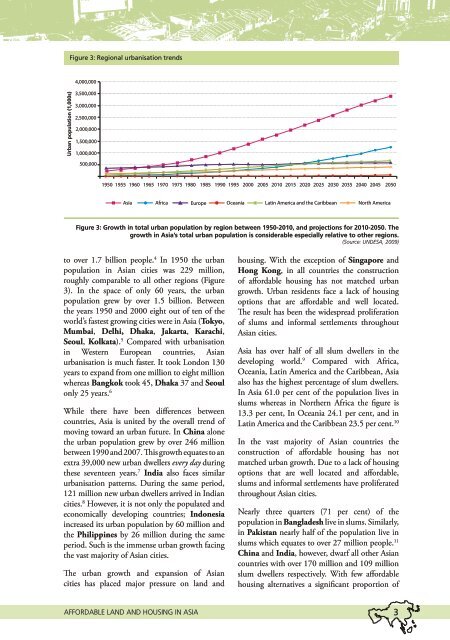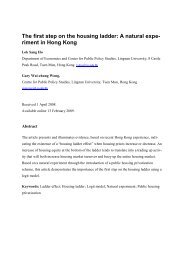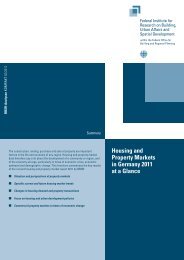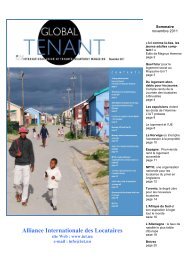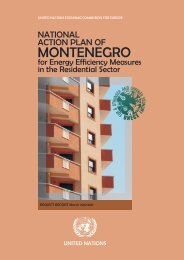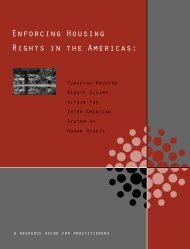1. INTRODUCTION –AFFORDABLE HOUSINGIN THE REGIONALCONTEXTAccess to adequate <strong>and</strong> <strong>affordable</strong> <strong>hous<strong>in</strong>g</strong> is acurrent <strong>and</strong> grow<strong>in</strong>g problem <strong>in</strong> a majority <strong>of</strong>countries <strong>in</strong> Asia. In some cases it is not that<strong>hous<strong>in</strong>g</strong> is too expensive but rather that <strong>in</strong>comesare too low. In other cases <strong>in</strong>comes are relativelyhigh but <strong>hous<strong>in</strong>g</strong> supply <strong>and</strong> f<strong>in</strong>ance is limited<strong>and</strong> hence expensive. All over Asia householdsare forced to live <strong>in</strong> <strong>in</strong>adequate <strong>hous<strong>in</strong>g</strong>, mostly<strong>in</strong> slums <strong>and</strong> <strong>in</strong>formal settlements, because thereis an <strong>in</strong>sufficient supply <strong>of</strong> better quality <strong>hous<strong>in</strong>g</strong>at a cost they can afford. Indeed, all too <strong>of</strong>ten,poor households spend an <strong>in</strong>ord<strong>in</strong>ate share <strong>of</strong>their <strong>in</strong>comes on <strong>hous<strong>in</strong>g</strong>. Consequently, manyhave to reduce expenditure on other basic needs,such as food, education <strong>and</strong> health, <strong>in</strong> order tomeet <strong>hous<strong>in</strong>g</strong> needs.Rapid <strong>and</strong> susta<strong>in</strong>ed urban <strong>and</strong> populationgrowth <strong>in</strong> Asia are fuell<strong>in</strong>g the dem<strong>and</strong> for welllocated,adequate <strong>and</strong> <strong>affordable</strong> <strong>hous<strong>in</strong>g</strong>. Whilethe population <strong>in</strong> some Western <strong>and</strong> EasternEuropean cities is actually decreas<strong>in</strong>g, not oneAsian city is shr<strong>in</strong>k<strong>in</strong>g. ‘Urbanization <strong>in</strong> Asia<strong>in</strong>volves around 44 million people be<strong>in</strong>g added tothe population <strong>in</strong> cities every year’ which equatesto a further 120,000 people per day added to theurban population. 1This growth requires the construction <strong>of</strong> morethan 20,000 new dwell<strong>in</strong>gs per day. 2Asia is also different to Africa <strong>and</strong> Lat<strong>in</strong>America <strong>in</strong> that it has unmistakable precedents<strong>of</strong> countries that have solved their <strong>hous<strong>in</strong>g</strong>problems. S<strong>in</strong>gapore <strong>and</strong> Hong Kong, forexample, have successfully achieved more or lessuniversal access to adequate <strong>hous<strong>in</strong>g</strong> through arange <strong>of</strong> policy <strong>in</strong>terventions. Historically theytoo had slums <strong>and</strong> significant affordability issues,just as neighbour<strong>in</strong>g countries such as Malaysia,Indonesia <strong>and</strong> the Philipp<strong>in</strong>es face today.In light <strong>of</strong> the grow<strong>in</strong>g affordability problemthis publication exam<strong>in</strong>es the status <strong>of</strong> <strong>affordable</strong><strong>l<strong>and</strong></strong> <strong>and</strong> <strong>hous<strong>in</strong>g</strong> <strong>in</strong> Asian countries. It beg<strong>in</strong>sby <strong>in</strong>troduc<strong>in</strong>g Asia <strong>and</strong> then briefly reviewshistorical <strong>hous<strong>in</strong>g</strong> trends <strong>and</strong> patterns that haveshaped current <strong>hous<strong>in</strong>g</strong> policy <strong>and</strong> discourse.Follow<strong>in</strong>g this the paper explores the status quo<strong>of</strong> <strong>affordable</strong> <strong>l<strong>and</strong></strong> <strong>and</strong> <strong>hous<strong>in</strong>g</strong> by outl<strong>in</strong><strong>in</strong>gaspects such as <strong>hous<strong>in</strong>g</strong> needs, quality, tenuremodalities, <strong>and</strong> affordability. Then, prom<strong>in</strong>entaspects <strong>of</strong> <strong>hous<strong>in</strong>g</strong> affordability are explored,for example <strong>l<strong>and</strong></strong> supply, <strong>hous<strong>in</strong>g</strong> f<strong>in</strong>ance,government <strong>hous<strong>in</strong>g</strong>-delivery programmes, <strong>and</strong>slum upgrad<strong>in</strong>g <strong>in</strong>itiatives. The publication endsby review<strong>in</strong>g the lessons learnt <strong>and</strong> provid<strong>in</strong>gsome recommendations for how to <strong>in</strong>crease<strong>affordable</strong> <strong>l<strong>and</strong></strong> <strong>and</strong> <strong>hous<strong>in</strong>g</strong> at the large-scalethat is required <strong>in</strong> Asia.1.1 ASIA: URBAN CHALLENGESAND URBAN OPPORTUNITIESUrbanisation has placed significant pressure <strong>of</strong><strong>hous<strong>in</strong>g</strong> affordability <strong>in</strong> Asian cities. The urbanpopulation <strong>of</strong> Asia comprises 50.3 per cent <strong>of</strong>the world’s total urban population, equat<strong>in</strong>gFigure 2: Asia comprises countries from Turkey across to Japan, from Mongolia down to Indonesia.2PART ONE
Figure 3: Regional urbanisation trends4,000,000Urban population (1,000s)3,500,0003,000,0002,500,0002,000,0001,500,0001,000,000500,0001950 1955 1960 1965 1970 1975 1980 1985 1990 1995 2000 2005 2010 2015 2020 2025 2030 2035 2040 2045 2050AsiaAfrica Europe Oceania Lat<strong>in</strong> America <strong>and</strong> the CaribbeanNorth AmericaFigure 3: Growth <strong>in</strong> total urban population by region between 1950-2010, <strong>and</strong> projections for 2010-2050. Thegrowth <strong>in</strong> Asia’s total urban population is considerable especially relative to other regions.(Source: UNDESA, 2009)to over 1.7 billion people. 4 In 1950 the urbanpopulation <strong>in</strong> Asian cities was 229 million,roughly comparable to all other regions (Figure3). In the space <strong>of</strong> only 60 years, the urbanpopulation grew by over 1.5 billion. Betweenthe years 1950 <strong>and</strong> 2000 eight out <strong>of</strong> ten <strong>of</strong> theworld’s fastest grow<strong>in</strong>g cities were <strong>in</strong> Asia (Tokyo,Mumbai, Delhi, Dhaka, Jakarta, Karachi,Seoul, Kolkata). 5 Compared with urbanisation<strong>in</strong> Western European countries, Asianurbanisation is much faster. It took London 130years to exp<strong>and</strong> from one million to eight millionwhereas Bangkok took 45, Dhaka 37 <strong>and</strong> Seoulonly 25 years. 6While there have been differences betweencountries, Asia is united by the overall trend <strong>of</strong>mov<strong>in</strong>g toward an urban future. In Ch<strong>in</strong>a alonethe urban population grew by over 246 millionbetween 1990 <strong>and</strong> 2007. This growth equates to anextra 39,000 new urban dwellers every day dur<strong>in</strong>gthese seventeen years. 7 India also faces similarurbanisation patterns. Dur<strong>in</strong>g the same period,121 million new urban dwellers arrived <strong>in</strong> Indiancities. 8 However, it is not only the populated <strong>and</strong>economically develop<strong>in</strong>g countries; Indonesia<strong>in</strong>creased its urban population by 60 million <strong>and</strong>the Philipp<strong>in</strong>es by 26 million dur<strong>in</strong>g the sameperiod. Such is the immense urban growth fac<strong>in</strong>gthe vast majority <strong>of</strong> Asian cities.The urban growth <strong>and</strong> expansion <strong>of</strong> Asiancities has placed major pressure on <strong>l<strong>and</strong></strong> <strong>and</strong><strong>hous<strong>in</strong>g</strong>. With the exception <strong>of</strong> S<strong>in</strong>gapore <strong>and</strong>Hong Kong, <strong>in</strong> all countries the construction<strong>of</strong> <strong>affordable</strong> <strong>hous<strong>in</strong>g</strong> has not matched urbangrowth. Urban residents face a lack <strong>of</strong> <strong>hous<strong>in</strong>g</strong>options that are <strong>affordable</strong> <strong>and</strong> well located.The result has been the widespread proliferation<strong>of</strong> slums <strong>and</strong> <strong>in</strong>formal settlements throughoutAsian cities.Asia has over half <strong>of</strong> all slum dwellers <strong>in</strong> thedevelop<strong>in</strong>g world. 9 Compared with Africa,Oceania, Lat<strong>in</strong> America <strong>and</strong> the Caribbean, Asiaalso has the highest percentage <strong>of</strong> slum dwellers.In Asia 61.0 per cent <strong>of</strong> the population lives <strong>in</strong>slums whereas <strong>in</strong> Northern Africa the figure is13.3 per cent, In Oceania 24.1 per cent, <strong>and</strong> <strong>in</strong>Lat<strong>in</strong> America <strong>and</strong> the Caribbean 23.5 per cent. 10In the vast majority <strong>of</strong> Asian countries theconstruction <strong>of</strong> <strong>affordable</strong> <strong>hous<strong>in</strong>g</strong> has notmatched urban growth. Due to a lack <strong>of</strong> <strong>hous<strong>in</strong>g</strong>options that are well located <strong>and</strong> <strong>affordable</strong>,slums <strong>and</strong> <strong>in</strong>formal settlements have proliferatedthroughout Asian cities.Nearly three quarters (71 per cent) <strong>of</strong> thepopulation <strong>in</strong> Bangladesh live <strong>in</strong> slums. Similarly,<strong>in</strong> Pakistan nearly half <strong>of</strong> the population live <strong>in</strong>slums which equates to over 27 million people. 11Ch<strong>in</strong>a <strong>and</strong> India, however, dwarf all other Asiancountries with over 170 million <strong>and</strong> 109 millionslum dwellers respectively. With few <strong>affordable</strong><strong>hous<strong>in</strong>g</strong> alternatives a significant proportion <strong>of</strong>AFFORDABLE LAND <strong>and</strong> HOUSING IN Asia3
- Page 3: AFFORDABLE LANDAND HOUSING IN ASIAV
- Page 7 and 8: 3.2.1 HOUSING POLICY AND LEGISLATIV
- Page 13 and 14: LIST OF FIGURESFigure 1: A woman pr
- Page 15 and 16: LIST OF TABLESTable 1: Regional urb
- Page 17: 1PART oneIntroduction- affordableho
- Page 24 and 25: Figure 7: High-rise multi-household
- Page 26 and 27: can be found throughout Asian citie
- Page 28 and 29: AFFORDABLEHOUSING ISBROADLY DEFINED
- Page 30 and 31: Figure 9: Slum housing in South Asi
- Page 32 and 33: The housingstock in manycountries i
- Page 34 and 35: 2. THE STATE OFAFFORDABLE LANDAND H
- Page 36 and 37: 9.3 square metres in 1998. 62 A stu
- Page 38 and 39: An analysis of sufficient living ar
- Page 40 and 41: POORER URBANHOUSEHOLDSIN ASIA SIMPL
- Page 42 and 43: THE FORMAL SECTORPlan Service Build
- Page 44 and 45: PART TWO ENDNOTES49 Nenova, T. (201
- Page 46 and 47: Over the lasttwo decadesmicrofinanc
- Page 48 and 49: 3. ADDRESSINGTHE CHALLENGE:AFFORDAB
- Page 50 and 51: HOUSING IS ACATALYST FORSOCIO-ECONO
- Page 52 and 53: lower- to middle-income groups. How
- Page 54 and 55: Grihayan Tahabil (Housing Fund) thr
- Page 56 and 57: provision, especially in countries
- Page 58 and 59: heritage, infrastructure and servic
- Page 60 and 61: market transactions. All units are
- Page 62 and 63: Boatu and Chengdu alone, 600,000 pe
- Page 64 and 65: have built an estimated 700,000 dwe
- Page 66 and 67: 3.2.7 The contribution of NGOsThe m
- Page 68 and 69:
quantity and at an affordable cost,
- Page 70 and 71:
OVER THE LASTTWO DECADESMICROFINANC
- Page 72 and 73:
Table 7: Community savings groups i
- Page 74 and 75:
RemittancesRemittances-money transf
- Page 76 and 77:
PART THREE ENDNOTES101 UNCHS (1997a
- Page 78 and 79:
Access toadequate andaffordablehous
- Page 80 and 81:
4. NOTABLE TRENDS,RECOMMENDATIONSAN
- Page 82 and 83:
Overcoming discrimination against w
- Page 84 and 85:
Affordable housing for plantation w
- Page 86 and 87:
opportunities to solve the underemp
- Page 88 and 89:
of other housing delivery systems t
- Page 90 and 91:
PART FOUR ENDNOTES201 UNCHS (1997b)
- Page 92 and 93:
76 PART FIVE
- Page 94 and 95:
AAcioly, C. Jr. (2008). Housing Str
- Page 96 and 97:
JJack, M. (2006). Urbanisation, sus
- Page 98 and 99:
Tipple, A. G. and A. Salim (1999).
- Page 100 and 101:
WWang, Y. P. (2004). Urban poverty,
- Page 102:
AFFORDABLE LANDAND HOUSING INASIAAf


